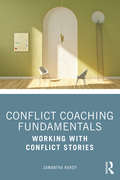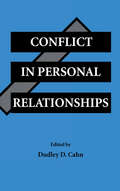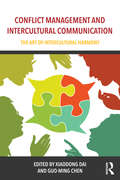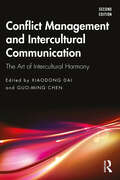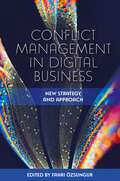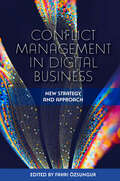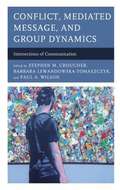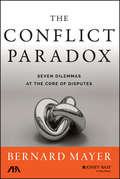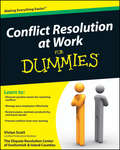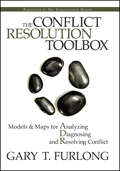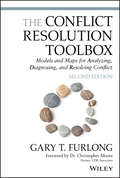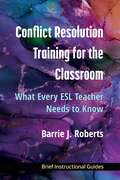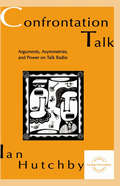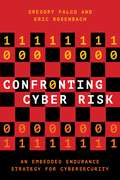- Table View
- List View
Conflict Coaching Fundamentals: Working With Conflict Stories
by Samantha HardyWe naturally create stories to help us making meaning of our world, but in conflict situations the kinds of stories we typically tell ourselves can actually make it harder for us to manage and resolve the conflict constructively. This book provides an accessible framework for understanding why people tell their conflict stories the way they do, and how to help them move away from conflict stories that prevent them from understanding and responding to conflict in an effective way. Presented using highly engaging and accessible cases, the book is designed to help people working with others in conflict to fully support them by understanding which areas of the conflict story to focus their attention on, and using practical techniques to support people to rewrite their story into a more constructive one to better manage the situation. The book also provides practical strategies to help people who are themselves in a conflict scenario to rewrite and enact a version of their conflict story that helps them to more constructively manage, and often resolve, their situation. A conflict management coaching system is introduced that is designed to address the particular problems created by dysfunctional conflict stories. This is a book specifically for those who work with people in conflict (mediators, conflict coaches, managers, lawyers, HR staff, teachers) and also for anyone who wishes to better understand their own experience of conflict.
Conflict Coaching Fundamentals: Working With Conflict Stories
by Samantha HardyWe naturally create stories to help us making meaning of our world, but in conflict situations the kinds of stories we typically tell ourselves can actually make it harder for us to manage and resolve the conflict constructively. This book provides an accessible framework for understanding why people tell their conflict stories the way they do, and how to help them move away from conflict stories that prevent them from understanding and responding to conflict in an effective way. Presented using highly engaging and accessible cases, the book is designed to help people working with others in conflict to fully support them by understanding which areas of the conflict story to focus their attention on, and using practical techniques to support people to rewrite their story into a more constructive one to better manage the situation. The book also provides practical strategies to help people who are themselves in a conflict scenario to rewrite and enact a version of their conflict story that helps them to more constructively manage, and often resolve, their situation. A conflict management coaching system is introduced that is designed to address the particular problems created by dysfunctional conflict stories. This is a book specifically for those who work with people in conflict (mediators, conflict coaches, managers, lawyers, HR staff, teachers) and also for anyone who wishes to better understand their own experience of conflict.
Conflict in Personal Relationships (Routledge Communication Series)
by Dudley D. CahnIn keeping with a broad conception of interpersonal conflict, this book is organized into two parts. The first focuses on conflict on different types of couple relationships -- homosexual, cross cultural, dating but violent, engaged, and married -- and group relationships -- student peers, parents and their young children, and adult children and their aging parents. The chapters not only review past research on conflict in some relationships, but also take a significant step forward in introducing a variety of other relationship types for future research on conflict. These chapters also offer evidence that conflict is experienced differently in different types of interpersonal relationships. The second part of this book describes basic underlying principles and programs for dealing with interpersonal conflicts. Chapters in this section discuss patterns of argument in everyday life, issues associated with competence in interpersonal conflict, and mediation as a form of intervention for resolution.
Conflict in Personal Relationships (Routledge Communication Series)
by Dudley D. CahnIn keeping with a broad conception of interpersonal conflict, this book is organized into two parts. The first focuses on conflict on different types of couple relationships -- homosexual, cross cultural, dating but violent, engaged, and married -- and group relationships -- student peers, parents and their young children, and adult children and their aging parents. The chapters not only review past research on conflict in some relationships, but also take a significant step forward in introducing a variety of other relationship types for future research on conflict. These chapters also offer evidence that conflict is experienced differently in different types of interpersonal relationships. The second part of this book describes basic underlying principles and programs for dealing with interpersonal conflicts. Chapters in this section discuss patterns of argument in everyday life, issues associated with competence in interpersonal conflict, and mediation as a form of intervention for resolution.
Conflict Management and Intercultural Communication: The Art of Intercultural Harmony
by Xiaodong Dai Guo-Ming ChenIn the globally interconnected world, conflicts often arise as a result of tensions between different cultural perceptions and diverse social preferences. Effectively managing conflicts and harmonizing intercultural relationships are essential tasks of intercultural communication research. This book seeks to find effective intercultural conflict management solutions by bringing together a group of leading international scholars from different disciplines to tackle the problem. Consisting of two parts, this book covers major theoretical perspectives of conflict management and harmony development in the first and conflict management and harmony development in different cultural contexts in the second. Integrating the latest work on conflict management and intercultural harmony, Conflict Management and Intercultural Communication takes an interdisciplinary approach, adopts diverse perspectives, and provides for a wide range of discussions. It will serve as a useful resource for teachers, researchers, students and professionals alike.
Conflict Management and Intercultural Communication: The Art of Intercultural Harmony
by Xiaodong Dai Guo-Ming ChenIn the globally interconnected world, conflicts often arise as a result of tensions between different cultural perceptions and diverse social preferences. Effectively managing conflicts and harmonizing intercultural relationships are essential tasks of intercultural communication research. This book seeks to find effective intercultural conflict management solutions by bringing together a group of leading international scholars from different disciplines to tackle the problem. Consisting of two parts, this book covers major theoretical perspectives of conflict management and harmony development in the first and conflict management and harmony development in different cultural contexts in the second. Integrating the latest work on conflict management and intercultural harmony, Conflict Management and Intercultural Communication takes an interdisciplinary approach, adopts diverse perspectives, and provides for a wide range of discussions. It will serve as a useful resource for teachers, researchers, students and professionals alike.
Conflict Management and Intercultural Communication: The Art of Intercultural Harmony
by Xiaodong Dai Guo-Ming ChenConflict management and harmony building are two key issues of intercultural communication research and merit particular attention in the globally interconnected world. In the expanded second edition, the book explores the effective ways to manage intercultural conflict and develop intercultural harmony, and takes an interdisciplinary approach to address the two issues. The book begins with the theoretical perspectives on conflict management and harmony building. It examines intercultural communication ethics, diversity and inclusion, conflict resolution, conflict face negotiation, and intercultural competence. It presents both Western and non-Western perspectives. The book then addresses in its second section conflict management and harmony building in specific contexts. These include communication in intergenerational relationships, multinational corporations, and virtual spaces, and covers a range of national cultures including the USA, Japan, Germany, and China. Drawing on the current research findings, this book covers the major theoretical perspectives and provides for a wide range of discussions on intercultural conflict management. It is a crucial reference for teachers, students, researchers, and practitioners alike.
Conflict Management and Intercultural Communication: The Art of Intercultural Harmony
by Xiaodong Dai Guo-Ming ChenConflict management and harmony building are two key issues of intercultural communication research and merit particular attention in the globally interconnected world. In the expanded second edition, the book explores the effective ways to manage intercultural conflict and develop intercultural harmony, and takes an interdisciplinary approach to address the two issues. The book begins with the theoretical perspectives on conflict management and harmony building. It examines intercultural communication ethics, diversity and inclusion, conflict resolution, conflict face negotiation, and intercultural competence. It presents both Western and non-Western perspectives. The book then addresses in its second section conflict management and harmony building in specific contexts. These include communication in intergenerational relationships, multinational corporations, and virtual spaces, and covers a range of national cultures including the USA, Japan, Germany, and China. Drawing on the current research findings, this book covers the major theoretical perspectives and provides for a wide range of discussions on intercultural conflict management. It is a crucial reference for teachers, students, researchers, and practitioners alike.
Conflict Management in Digital Business: New Strategy and Approach
by Fahri ÖzsungurToday's business world is under constant digital threats that can cause unpredictable damage and weaken the competitiveness of businesses. With digital transformation risks and cyber-attacks increased by extraordinary situations such as the recent pandemic, new approaches are needed in the management of these emerging digital conflicts to develop sustainable business strategies and become a robust business of the future. Conflict Management in Digital Business: New Strategy and Approach is a pioneering and innovative guide in the context of digital conflicts in the value chain of businesses and on digital conflicts in business management and strategy. Conflict management is discussed in the context of issues of production and planning, logistics, marketing, procurement, technology development, human resource management, and business infrastructure. Sectoral issues with conflicting businesses, organizational behavior, digital sustainability, cyber business management, cyber-attack, and cyberwarfare strategies for businesses are discussed in detail to bring crucial principles in the context of management and strategy to all businesses that desire to be a business of the future. Providing readers with a unique guide of how businesses can achieve resilience to digital conflict, Conflict Management in Digital Business helps prepare for unexpected situations such as pandemics, to maintain competitive advantage, and illuminating pathways to turn conflicts caused by extraordinary situations into opportunities.
Conflict Management in Digital Business: New Strategy and Approach
by Fahri ÖzsungurToday's business world is under constant digital threats that can cause unpredictable damage and weaken the competitiveness of businesses. With digital transformation risks and cyber-attacks increased by extraordinary situations such as the recent pandemic, new approaches are needed in the management of these emerging digital conflicts to develop sustainable business strategies and become a robust business of the future. Conflict Management in Digital Business: New Strategy and Approach is a pioneering and innovative guide in the context of digital conflicts in the value chain of businesses and on digital conflicts in business management and strategy. Conflict management is discussed in the context of issues of production and planning, logistics, marketing, procurement, technology development, human resource management, and business infrastructure. Sectoral issues with conflicting businesses, organizational behavior, digital sustainability, cyber business management, cyber-attack, and cyberwarfare strategies for businesses are discussed in detail to bring crucial principles in the context of management and strategy to all businesses that desire to be a business of the future. Providing readers with a unique guide of how businesses can achieve resilience to digital conflict, Conflict Management in Digital Business helps prepare for unexpected situations such as pandemics, to maintain competitive advantage, and illuminating pathways to turn conflicts caused by extraordinary situations into opportunities.
Conflict, Mediated Message, and Group Dynamics: Intersections of Communication (PDF)
by Stephen M. Croucher Mariyan Tomov Nelly Velinova Cheng Zeng Barbara Lewandowska-Tomaszczyk Paul A. Wilson Shawn Condon Miko 322 Aj Deckert Audra Diers-Lawson Flora Galy-Badenas Elvis Ngwayuh Lilia RaychevaConflict, Mediated Message, and Group Dynamics: Intersections of Communication establishes a framework to explore the ways emotions enter a conflict scenario and investigate their role as either causes or consequences of conflict. This edited collection's chapters shed light on the questions of the extent to which context on the one hand and culture-related dimensions on the other are conducive to conflict dynamicity and management either by calming emotions--and conflict--or by increasing their severity.
The Conflict Paradox: Seven Dilemmas at the Core of Disputes
by Bernard S. MayerFind the roadmap to the heart of the conflict The Conflict Paradox is a guide to taking conflict to a more productive place. Written by one of the founders of the professional conflict management field and co-published with the American Bar Association, this book outlines seven major dilemmas that conflict practitioners face every day. Readers will find expert guidance toward getting to the heart of the conflict and will be challenged to adopt a new way to think about the choices disputants face,. They will also be offered practical tools and techniques for more successful intervention. Using stories, experiences, and reflective exercises to bring these concepts to life, the author provides actionable advice for overcoming roadblocks to effective conflict work. Disputants and interveners alike are often stymied by what appear to be unacceptable alternatives,. The Conflict Paradox offers a new way of understanding and working with these so that they become not obstacles but opportunities for helping people move through conflict successfully.. Examine the contradictions at the center of almost all conflicts Learn how to bring competition and cooperation, avoidance and engagement, optimism and realism together to make for more power conflict intervention Deal effectively with the tensions between emotions, and logic, principles and compromise, neutrality and advocacy, community and autonomy Discover the tools and techniques that make conflicts less of a hurdle to overcome and more of an opportunity to pursue Conflict is everywhere, and conflict intervention skills are valuable far beyond the professional and legal realms. With insight and creativity, solutions are almost always possible. For conflict interveners and disputants looking for an effective and creative approach to understanding and working with conflict , The Conflict Paradox provides a powerful and important roadmap for conflict intervention.
The Conflict Paradox: Seven Dilemmas at the Core of Disputes
by Bernard S. MayerFind the roadmap to the heart of the conflict The Conflict Paradox is a guide to taking conflict to a more productive place. Written by one of the founders of the professional conflict management field and co-published with the American Bar Association, this book outlines seven major dilemmas that conflict practitioners face every day. Readers will find expert guidance toward getting to the heart of the conflict and will be challenged to adopt a new way to think about the choices disputants face,. They will also be offered practical tools and techniques for more successful intervention. Using stories, experiences, and reflective exercises to bring these concepts to life, the author provides actionable advice for overcoming roadblocks to effective conflict work. Disputants and interveners alike are often stymied by what appear to be unacceptable alternatives,. The Conflict Paradox offers a new way of understanding and working with these so that they become not obstacles but opportunities for helping people move through conflict successfully.. Examine the contradictions at the center of almost all conflicts Learn how to bring competition and cooperation, avoidance and engagement, optimism and realism together to make for more power conflict intervention Deal effectively with the tensions between emotions, and logic, principles and compromise, neutrality and advocacy, community and autonomy Discover the tools and techniques that make conflicts less of a hurdle to overcome and more of an opportunity to pursue Conflict is everywhere, and conflict intervention skills are valuable far beyond the professional and legal realms. With insight and creativity, solutions are almost always possible. For conflict interveners and disputants looking for an effective and creative approach to understanding and working with conflict , The Conflict Paradox provides a powerful and important roadmap for conflict intervention.
Conflict Resolution at Work For Dummies
by Vivian ScottA practical workplace guide to handling conflict effectively Managing employees and encouraging them to work together toward a common goal is an essential skill that all leaders should possess. Conflict Resolution at Work For Dummies provides the tools and advice you need to restore peace, train your colleagues to get along better with others, prevent conflicts from ever starting, and maintain better productivity while boosting morale. One of the only trade publications that takes the manager's perspective on how to address conflicts, resolve disputes, and restore peace and productivity to the workplace Examines more positive means for resolving conflicts (other than arguing, surrendering, running away, filing a lawsuit, etc.) Helps managers and employees sort through problems and make the workplace a more rewarding place No manager should be without Conflict Resolution at Work For Dummies!
Conflict Resolution at Work For Dummies
by Vivian ScottA practical workplace guide to handling conflict effectively Managing employees and encouraging them to work together toward a common goal is an essential skill that all leaders should possess. Conflict Resolution at Work For Dummies provides the tools and advice you need to restore peace, train your colleagues to get along better with others, prevent conflicts from ever starting, and maintain better productivity while boosting morale. One of the only trade publications that takes the manager's perspective on how to address conflicts, resolve disputes, and restore peace and productivity to the workplace Examines more positive means for resolving conflicts (other than arguing, surrendering, running away, filing a lawsuit, etc.) Helps managers and employees sort through problems and make the workplace a more rewarding place No manager should be without Conflict Resolution at Work For Dummies!
The Conflict Resolution Toolbox: Models and Maps for Analyzing, Diagnosing, and Resolving Conflict
by Gary T. FurlongIn real-life conflict resolution situations, one size does not fit all. Just as a mechanic does not fix every car with the same tool, the conflict resolution practitioner cannot hope to resolve every dispute using the same technique. Practitioners need to be comfortable with a wide variety of tools to diagnose different problems, in vastly different circumstances, with different people, and resolve these conflicts effectively. The Conflict Resolution Toolbox gives you all the tools you need: eight different models for dealing with the many conflict situations you encounter in your practice. This book bridges the gap between theory and practice and goes beyond just one single model to present a complete toolbox - a range of models that can be used to analyze, diagnose, and resolve conflict in any situation. It shows mediators, negotiators, managers, and anyone needing to resolve conflict how to simply and effectively understand and assess the situations of conflict they face. And it goes a step further, offering specific, practical guidance on how to intervene to resolve the conflict successfully. Each model provides a different and potentially useful angle on the problem, and includes worksheets and a step-by-step process to guide the reader in applying the tools. Offers eight models to help you understand the root causes of any conflict. Explains each model's focus, what kind of situations it can be useful in and, most importantly, what interventions are likely to help. Provides you with clear direction on what specific actions to choose to resolve a particular type of conflict effectively. Features a detailed case study throughout the book, to which each model is applied. Additional examples and case studies unique to each chapter give the reader a further chance to see the models in action. Includes practical tools and worksheets that you can use in working with these models in your practice. The Conflict Resolution Toolbox equips any practitioner to resolve a wide range of conflicts. Mediators, negotiators, lawyers, managers and supervisors, insurance adjusters, social workers, human resource and labour relations specialists, and others will have all the tools they need for successful conflict resolution.
The Conflict Resolution Toolbox: Models and Maps for Analyzing, Diagnosing, and Resolving Conflict
by Gary T. FurlongIn real-life conflict resolution situations, one size does not fit all. Just as a mechanic does not fix every car with the same tool, the conflict resolution practitioner cannot hope to resolve every dispute using the same technique. Practitioners need to be comfortable with a wide variety of tools to diagnose different problems, in vastly different circumstances, with different people, and resolve these conflicts effectively. The Conflict Resolution Toolbox gives you all the tools you need: eight different models for dealing with the many conflict situations you encounter in your practice. This book bridges the gap between theory and practice and goes beyond just one single model to present a complete toolbox - a range of models that can be used to analyze, diagnose, and resolve conflict in any situation. It shows mediators, negotiators, managers, and anyone needing to resolve conflict how to simply and effectively understand and assess the situations of conflict they face. And it goes a step further, offering specific, practical guidance on how to intervene to resolve the conflict successfully. Each model provides a different and potentially useful angle on the problem, and includes worksheets and a step-by-step process to guide the reader in applying the tools. Offers eight models to help you understand the root causes of any conflict. Explains each model's focus, what kind of situations it can be useful in and, most importantly, what interventions are likely to help. Provides you with clear direction on what specific actions to choose to resolve a particular type of conflict effectively. Features a detailed case study throughout the book, to which each model is applied. Additional examples and case studies unique to each chapter give the reader a further chance to see the models in action. Includes practical tools and worksheets that you can use in working with these models in your practice. The Conflict Resolution Toolbox equips any practitioner to resolve a wide range of conflicts. Mediators, negotiators, lawyers, managers and supervisors, insurance adjusters, social workers, human resource and labour relations specialists, and others will have all the tools they need for successful conflict resolution.
The Conflict Resolution Toolbox: Models and Maps for Analyzing, Diagnosing, and Resolving Conflict
by Gary T. FurlongPRAISE FOR THE CONFLICT RESOLUTION TOOLBOX SECOND EDITION "I have been using and recommending The Conflict Resolution Toolbox since its first edition. It is rare to find a resource with such practical tools in a field that is so concrete, but often struggles to bridge theory and practice. In this increasingly complex world, it is vital to have models to resort to when we reach impasse in conflict. I recommend The Conflict Resolution Toolbox to anyone engaged in resolving conflicts in any discipline." —Martha E. Simmons, JD, LLM, PHD, Academic Director, Winkler Institute of Dispute Resolution and Director, Mediation Clinic and Intensive Program, Toronto, Canada "We all know one thing about conflict: It is messy! Furlong's models offer mediators, facilitators, lawyers, psychotherapists and others 'a leg up' in more swiftly figuring out what is going on and what is needed. Furlong does not offer up a single 'truth', style or theory, so much as a collection of effective tools that professionals, groups and families can use to better understand what they are experiencing and how they can approach achieving better results. Highly recommended!" —James C. Melamed, JD, CEO, Mediate.com "Gary Furlong has done it again! A long-time leader in the conflict resolution field, Gary has added two new 'power tools' to what was already the essential conflict resolution toolkit. His new chapters in this Second Edition deal with 'The Law of Reciprocity' and 'Loss Aversion Bias'. I am proud and thankful to add this book to my already growing conflict resolution bookcase, knowing that this is a volume I will go to again and again. I highly recommend it for anyone in the field." —Rick Weiler, Mediator, Arbitrator, Weiler ADR Inc., Ottawa, Canada "Gary Furlong uniquely provides invaluable, practical tools that help in understanding, preventing, and resolving conflict. This is a must-have reference book for anyone who cares about mitigating the role destructive conflict plays in our professional and personal lives and finding strategic benefit in tools that work. Gary has created a book that is both aspirational and practical. It's so challenging to create simple-to-use tools supported by complex concepts and Gary does this better than anyone." —Joshua A. Gordon, JD, MA, Arbitrator for the Court of Arbitration of Sport, Senior Practitioner at the Sports Conflict Institute, and Woodard Family Foundation Fellow Senior Instructor of Sports Business at the University of Oregon Lundquist College of Business
The Conflict Resolution Toolbox: Models and Maps for Analyzing, Diagnosing, and Resolving Conflict
by Gary T. FurlongPRAISE FOR THE CONFLICT RESOLUTION TOOLBOX SECOND EDITION "I have been using and recommending The Conflict Resolution Toolbox since its first edition. It is rare to find a resource with such practical tools in a field that is so concrete, but often struggles to bridge theory and practice. In this increasingly complex world, it is vital to have models to resort to when we reach impasse in conflict. I recommend The Conflict Resolution Toolbox to anyone engaged in resolving conflicts in any discipline." —Martha E. Simmons, JD, LLM, PHD, Academic Director, Winkler Institute of Dispute Resolution and Director, Mediation Clinic and Intensive Program, Toronto, Canada "We all know one thing about conflict: It is messy! Furlong's models offer mediators, facilitators, lawyers, psychotherapists and others 'a leg up' in more swiftly figuring out what is going on and what is needed. Furlong does not offer up a single 'truth', style or theory, so much as a collection of effective tools that professionals, groups and families can use to better understand what they are experiencing and how they can approach achieving better results. Highly recommended!" —James C. Melamed, JD, CEO, Mediate.com "Gary Furlong has done it again! A long-time leader in the conflict resolution field, Gary has added two new 'power tools' to what was already the essential conflict resolution toolkit. His new chapters in this Second Edition deal with 'The Law of Reciprocity' and 'Loss Aversion Bias'. I am proud and thankful to add this book to my already growing conflict resolution bookcase, knowing that this is a volume I will go to again and again. I highly recommend it for anyone in the field." —Rick Weiler, Mediator, Arbitrator, Weiler ADR Inc., Ottawa, Canada "Gary Furlong uniquely provides invaluable, practical tools that help in understanding, preventing, and resolving conflict. This is a must-have reference book for anyone who cares about mitigating the role destructive conflict plays in our professional and personal lives and finding strategic benefit in tools that work. Gary has created a book that is both aspirational and practical. It's so challenging to create simple-to-use tools supported by complex concepts and Gary does this better than anyone." —Joshua A. Gordon, JD, MA, Arbitrator for the Court of Arbitration of Sport, Senior Practitioner at the Sports Conflict Institute, and Woodard Family Foundation Fellow Senior Instructor of Sports Business at the University of Oregon Lundquist College of Business
Conflict Resolution Training for the Classroom: What Every ESL Teacher Needs to Know
by Barrie RobertsESL instructors without a background in conflict resolution (CR) who teach intermediate to advanced courses at colleges, universities, or in Intensive English Programs, may want to provide students with valuable negotiation and mediation skills. Author Barrie J. Roberts is an experienced ESL teacher, lawyer, mediator, and Alternative Dispute Resolution (ADR) Administrator for southern California Superior Courts. In this book, she draws upon her experience using these activities in a variety of ESL settings and courses with students from all over the world to inspire other ESL teachers to add CR approaches to their activities, lessons, and courses. Following an introduction to conflict resolution, Conflict Resolution Training for the Classroom shows how much of the teaching of CR is similar to teaching ESL. It outlines ways to apply negotiation and mediation to ESL activities, how to prevent and resolve conflicts, how to use specific types of role-plays to address conflicts, and how to design successful activities. The book also includes a list of resources and sample syllabi.
Conflict Resolution Training for the Classroom: What Every ESL Teacher Needs to Know
by Barrie RobertsESL instructors without a background in conflict resolution (CR) who teach intermediate to advanced courses at colleges, universities, or in Intensive English Programs, may want to provide students with valuable negotiation and mediation skills. Author Barrie J. Roberts is an experienced ESL teacher, lawyer, mediator, and Alternative Dispute Resolution (ADR) Administrator for southern California Superior Courts. In this book, she draws upon her experience using these activities in a variety of ESL settings and courses with students from all over the world to inspire other ESL teachers to add CR approaches to their activities, lessons, and courses. Following an introduction to conflict resolution, Conflict Resolution Training for the Classroom shows how much of the teaching of CR is similar to teaching ESL. It outlines ways to apply negotiation and mediation to ESL activities, how to prevent and resolve conflicts, how to use specific types of role-plays to address conflicts, and how to design successful activities. The book also includes a list of resources and sample syllabi.
Confrontation Talk: Arguments, Asymmetries, and Power on Talk Radio (Everyday Communication Series)
by Ian HutchbyUsing conversation analysis to explore the nature of argument, asymmetry, and power on talk radio, this book focuses on the interplay between the structures of talk in interaction and the structures of participation on talk radio. In the process, it demonstrates how conversation analysis may be used to account for power as a feature of institutional discourse. To address a number of key issues in the study of institutional communication and conflict talk, a case study of a British talk radio show is presented, stimulating some penetrating questions: * What is distinctive about interaction on talk radio? * What is the basis of the communicative asymmetries between hosts and callers? * How are their arguments constructed, and in what ways does the setting enable and constrain the production of conflict talk? These questions are answered through the detailed study of conversational phenomena, informed by a critical concern for the relationship between talk and social structure. This book will be of interest to a wide readership consisting of academics, advanced undergraduates, and postgraduate students in a range of courses in sociology, linguistics, media/communication/cultural studies, anthropology, and popular culture.
Confrontation Talk: Arguments, Asymmetries, and Power on Talk Radio (Everyday Communication Series)
by Ian HutchbyUsing conversation analysis to explore the nature of argument, asymmetry, and power on talk radio, this book focuses on the interplay between the structures of talk in interaction and the structures of participation on talk radio. In the process, it demonstrates how conversation analysis may be used to account for power as a feature of institutional discourse. To address a number of key issues in the study of institutional communication and conflict talk, a case study of a British talk radio show is presented, stimulating some penetrating questions: * What is distinctive about interaction on talk radio? * What is the basis of the communicative asymmetries between hosts and callers? * How are their arguments constructed, and in what ways does the setting enable and constrain the production of conflict talk? These questions are answered through the detailed study of conversational phenomena, informed by a critical concern for the relationship between talk and social structure. This book will be of interest to a wide readership consisting of academics, advanced undergraduates, and postgraduate students in a range of courses in sociology, linguistics, media/communication/cultural studies, anthropology, and popular culture.
Confronting Cyber Risk: An Embedded Endurance Strategy for Cybersecurity
by Gregory J. Falco Eric RosenbachAn adaptive cyber risk management guide from MIT scientist and Johns Hopkins professor Gregory Falco and "Cyber Czar" Eric Rosenbach Cyberattacks continue to grow in number, intensity, and sophistication. While attackers persistently adapt, business leaders have suffered from employing the same cyber risk management strategies for decades. Organizations must learn how to move past temporary solutions and invest in long-term resiliency measures to thrive in the future cyber economy. Confronting Cyber Risk: An Embedded Endurance Strategy for Cybersecurity is a practical leadership guidebook outlining a new strategy for improving organizational cybersecurity and mitigating cyber risk. Veteran cybersecurity experts Falco and Rosenbach introduce the Embedded Endurance strategy as a systems-level approach to cyber risk management which addresses interdependent components of organizational risk and prepares organizations for the inevitability of cyber threats over the long-term. Using real world examples from SolarWinds to the Colonial Pipeline attack, the authors extend beyond hardware and software to provide a thoughtful ten-step process for organizations to address the simultaneous operational, reputational, and litigation risks common to cyberattacks. They conclude with helpful "cryptograms" from the future, in which business leaders are confronted with the next generation of cyber risk challenges. Clear and informative, Confronting Cyber Risk provides CEOs and cyber newcomers alike with concrete guidance on how to implement a cutting-edge strategy to mitigate an organization's overall risk to malicious cyberattacks in an evolving cyber risk landscape.
Confronting Cyber Risk: An Embedded Endurance Strategy for Cybersecurity
by Eric Rosenbach Gregory J. FalcoAn adaptive cyber risk management guide from MIT scientist and Johns Hopkins professor Gregory Falco and "Cyber Czar" Eric Rosenbach Cyberattacks continue to grow in number, intensity, and sophistication. While attackers persistently adapt, business leaders have suffered from employing the same cyber risk management strategies for decades. Organizations must learn how to move past temporary solutions and invest in long-term resiliency measures to thrive in the future cyber economy. Confronting Cyber Risk: An Embedded Endurance Strategy for Cybersecurity is a practical leadership guidebook outlining a new strategy for improving organizational cybersecurity and mitigating cyber risk. Veteran cybersecurity experts Falco and Rosenbach introduce the Embedded Endurance strategy as a systems-level approach to cyber risk management which addresses interdependent components of organizational risk and prepares organizations for the inevitability of cyber threats over the long-term. Using real world examples from SolarWinds to the Colonial Pipeline attack, the authors extend beyond hardware and software to provide a thoughtful ten-step process for organizations to address the simultaneous operational, reputational, and litigation risks common to cyberattacks. They conclude with helpful "cryptograms" from the future, in which business leaders are confronted with the next generation of cyber risk challenges. Clear and informative, Confronting Cyber Risk provides CEOs and cyber newcomers alike with concrete guidance on how to implement a cutting-edge strategy to mitigate an organization's overall risk to malicious cyberattacks in an evolving cyber risk landscape.
